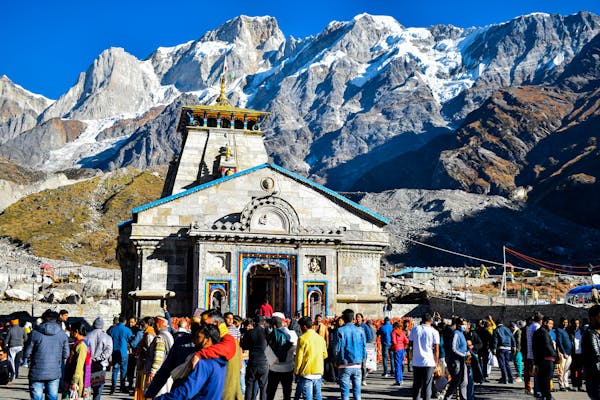Kedarnath Travel, Uttarakhand

Travel Ways (How to Reach)
Reaching Kedarnath is a journey filled with adventure and scenic beauty. You have several options to consider:
- By Air: The nearest airport is Dehradun Airport (Jolly Grant Airport), approximately 239 km away from Kedarnath. Upon arrival, you can hire a taxi or take a bus to Gaurikund, which is the starting point of the trek to Kedarnath. The flight offers breathtaking views of the Himalayan ranges, making your journey memorable right from the start.
- By Train: The closest railway station to Kedarnath is Haridwar, located about 254 km away. Haridwar is well-connected to major cities across India. Once you reach Haridwar, you can take a taxi or a state-run bus to Gaurikund. This route takes you through beautiful landscapes and small towns, giving you a glimpse of Uttarakhand’s culture.
- By Road: Kedarnath is accessible by road from various cities in Uttarakhand. You can either drive your own vehicle or take a bus to Gaurikund. The road journey offers stunning views of the mountains and rivers. The last 16 km to Kedarnath is a trek, which can take around 6-8 hours, depending on your pace.
Cloths Required
Given the high-altitude environment of Kedarnath, it's essential to pack appropriately:
- Warm Clothing: Layering is key; pack thermal inner wear, fleece jackets, and a waterproof and windproof outer jacket.
- Trekking Shoes: Invest in sturdy, comfortable trekking shoes with good grip to navigate the rugged terrain.
- Accessories: Don't forget woolen caps, gloves, and a good pair of sunglasses to protect against UV rays.
- Rain Gear: Carry a poncho or waterproof cover, especially if visiting during the monsoon season.
Things to Do
Kedarnath offers a range of activities for visitors:
- Temple Visit: Experience the spiritual atmosphere at the Kedarnath Temple, one of the 12 Jyotirlingas dedicated to Lord Shiva.
- Trekking: The trek to Kedarnath is an adventure in itself, with stunning views of the Himalayas and surrounding landscapes.
- Photography: Capture the breathtaking scenery, including the majestic Kedarnath peak and the serene Mandakini River.
- Evening Aarti: Attend the evening prayers (aarti) at the temple to witness a captivating spiritual ritual.
Places to Visit
Besides the temple, there are several attractions worth exploring:
- Bhairav Temple: Located a short distance from Kedarnath, this temple is dedicated to Lord Bhairav and offers stunning views of the valley.
- Gaurikund: The starting point of the trek, Gaurikund is famous for its hot springs and is a great place to relax before your journey.
- Chorabari Lake: Also known as Gandhi Sarovar, this serene lake is a perfect spot for nature lovers and photographers.
Famous Things to Do
Kedarnath is not just about the temple; it offers unique experiences:
- Spiritual Retreat: Engage in meditation and yoga in the tranquil surroundings to rejuvenate your mind and body.
- Cultural Immersion: Interact with local priests and villagers to learn about their customs and traditions.
- Shopping: Visit local markets for religious souvenirs, handicrafts, and traditional Uttarakhandi items.
Budget Analysis
Your budget will depend on your travel style, but here’s a general breakdown:
- Accommodation: ₹500-₹3,000 per night, depending on whether you choose budget guesthouses or mid-range hotels.
- Food: Meals typically range from ₹150-₹500. Local eateries offer affordable and delicious options.
- Transportation: Budget for taxis and buses, which can vary based on your travel preferences.
Trek Essentials
Prepare for your trek with the following essentials:
- Backpack: A comfortable backpack to carry your essentials, with good support for long hikes.
- Water Bottle: Stay hydrated; a reusable water bottle is a must.
- Energy Snacks: Carry energy bars, nuts, and fruits for quick energy boosts during the trek.
- First-Aid Kit: A basic kit with band-aids, antiseptic wipes, and any personal medications.
Duration to Spend
A typical trip to Kedarnath may span 3-4 days:
- Day 1: Travel to Gaurikund, acclimatize, and rest.
- Day 2: Begin the trek to Kedarnath, explore the temple, and participate in evening prayers.
- Day 3: Visit nearby attractions and trek back to Gaurikund.
- Day 4: Return journey to your starting point.
Trek Distance
The trek from Gaurikund to Kedarnath is approximately 16 km and typically takes 6-8 hours, depending on your pace and stamina.
Difficulty Level
The trek is considered moderately challenging. Good physical fitness is recommended, as some stretches may be steep and require endurance.
Best Season to Visit
The ideal time to visit Kedarnath is from May to October:
- Summer (May-June): Pleasant weather, making it ideal for trekking.
- Monsoon (July-August): While the temple remains open, heavy rains can make trekking difficult.
- Autumn (September-October): Clear skies and pleasant temperatures; a great time for trekking and sightseeing.
Hotel Rates and Stay Options
Accommodation in Kedarnath varies widely:
- Budget Options: Basic guesthouses starting at ₹500.
- Mid-Range Hotels: More comfortable options range from ₹1,000 to ₹3,000.
- Luxury Stays: While limited, there are a few premium accommodations available.
Food Rate
Food prices in Kedarnath are generally reasonable:
- Local Eateries: Meals cost around ₹150-₹300.
- Restaurants: Slightly upscale places may charge ₹300-₹500 for a meal.
Medicines to Carry for Emergency
It's crucial to be prepared for emergencies:
- Pain Relievers: Such as ibuprofen or paracetamol for headaches or body aches.
- Anti-Allergy Medication: For unexpected allergic reactions.
- Personal Prescriptions: Don’t forget any medications you regularly take.
- Basic First Aid Supplies: Band-aids, antiseptic wipes, and gauze.
About the Place
Kedarnath is one of the four Char Dham pilgrimage sites, revered by millions. Nestled in the Himalayas, the Kedarnath Temple stands at an altitude of 3,583 meters and is dedicated to Lord Shiva.
History and Mythology
Kedarnath holds significant importance in Hindu mythology. According to legend, the Pandavas sought Lord Shiva’s blessings here after the Kurukshetra war to atone for their sins. The temple is believed to have been built in the 8th century by Adi Shankaracharya, making it an essential pilgrimage site.
Comments
Post a Comment